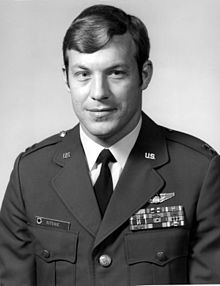28 August 1972 – Capt Richard Steven Ritchie served as an officer in the United States Air Force and the Colorado Air National Guard, and a general officer in the Air Force Reserve. Ritchie  joined Navy Commander Randy Cunningham as the only two pilots (along with three airborne Weapon systems officers) among the five American aces during the Vietnam War. Ritchie is a recipient of the Air Force Cross, the second-highest military decoration that can be awarded to a member of the United States Air Force. He is also the 30th most highly decorated individual in United States military history.
joined Navy Commander Randy Cunningham as the only two pilots (along with three airborne Weapon systems officers) among the five American aces during the Vietnam War. Ritchie is a recipient of the Air Force Cross, the second-highest military decoration that can be awarded to a member of the United States Air Force. He is also the 30th most highly decorated individual in United States military history.
From Wikipedia: Ritchie’s 5th “victory came August 28, 1972, while leading “Buick” flight, a MiGCAP for a strike north of Hanoi. During the preceding month Seventh Air Force had instituted daily centralized mission debriefings of leaders and planners from all fighter wings called “Linebacker Conferences.”[16] Ritchie had just started his flight of Combat Tree Phantoms on its return to base (Ritchie was flying the F-4D, AF Ser. No. 66-7463, in which he had scored his first kill). Red Crown, now the nuclear-powered guided-missile cruiser USS Long Beach, alerted the strike force to “Blue Bandits” (MiG-21s) 30 miles southwest of Hanoi, along the route back to Thailand. Approaching the area of the reported contact at 15,000 feet, Ritchie recalled recent Linebacker Conference information that MiGs had returned to using high altitude tactics and suspected the MiGs were high. Buick and Vega flights, both of the MiGCAP, flew toward the reported location.[17]
DeBellevue picked up the MiGs on the Phantom’s onboard radar and using Combat Tree, discovered that the MiGs were ten miles behind Olds flight, another flight of MiGCAP fighters returning to base. Ritchie called in the contact to warn Olds flight. Ritchie, concerned that MiGs might be at an altitude above them, made continuous requests for altitude readings to both Disco and Red Crown. He received location, heading, and speed data on the MiGs (now determined to be returning north at high speed to their base) but not altitude as Buick flight closed to within 15 miles of the MiGs. DeBellevue’s radar then painted the MiGs dead ahead at 25,000 feet, and Ritchie ordered the flight to light afterburners. DeBellevue warned Ritchie they were closing fast and were in range. About the same time Ritchie saw the MiGs himself headed in the opposite direction.[18]
Attacking in a climbing curve behind the MiG-21’s with his AIM-7 guidance radar locked on, Ritchie was given continuous range updates by DeBellevue. With his Phantom barely making enough speed to overtake the targets, Ritchie launched two Sparrows from over four miles away. The firing parameters of the two shots were out of the missiles’ performance envelope, an attempt to influence the MiGs to turn and thus shorten the range. Both shots not only missed but failed to influence the opponents. Moments later, tracking one MiG visually by the contrail it was making, Ritchie fired his remaining two Sparrows, also at long range. The first missed, but the MiG made a hard turn and actually shortened the range, and was destroyed by the second.[13][19] Short on fuel, Ritchie elected not to try to pursue the second MiG-21.
Ritchie commented:[5]
My fifth MiG kill was an exact duplicate of a syllabus mission (at Fighter Weapons School), so I had not only flown that as a student, but had taught it probably a dozen times prior to actually doing it in combat.”
